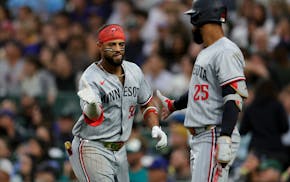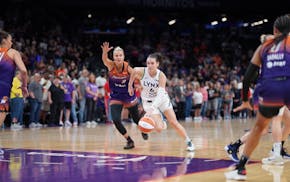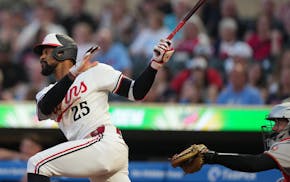The Twins were three outs away from almost completely changing the narrative on the start of their season.
After starting 0-4 and being outscored 28-6 in the process, all they needed was for one of their ace relievers to preserve a two-run lead. Had Griffin Jax done that, the Twins would be 4-1 since that awful start and 4-5 overall.
Instead, he coughed up the lead. The Twins lost in extra innings to fall to 3-6. And things feel less optimistic, though not as pessimistic as they did a week ago.
Even if Jax had slammed the door on the Astros, though, nothing about one particularly alarming early trend would have changed for the Twins.
Their starting pitching, an assumed strength on paper, has been horrendous through nine games. Yes, that's an extremely small sample size, but one metric bears watching in particular this season: innings pitched by the members of their rotation.
Patrick Reusse and I talked about it on Monday's Daily Delivery podcast.
Simply put: When the Twins have thrived, particularly since Rocco Baldelli arrived as manager in 2019, their starting pitchers have pitched relatively deep into games.
That's a sign of quality starting pitching in many cases, but not always. What I'm more concerned with here is the impact on the Twins' bullpen when starters aren't holding up (or being allowed to hold up) their end of the bargain. Let's go year-by-year, skipping the 60-game COVID year of 2020:
2019: We all remember the 307 home runs from the Bomba Squad and the 101 wins. What we remember less is a veteran-laden rotation in which none of the five primary starters worked fewer than 146 innings and as a group worked the sixth-most innings of any team in MLB. The bullpen wasn't great but benefited from a reasonable workload and finished No. 10 in reliever ERA in the majors.
2021: A disappointing 73-89 season that never got on track. Starters ranked No. 21 in MLB in innings pitched. The overtaxed bullpen was No. 20 in ERA.
2022: The most egregious example. The Twins ranked No. 27 in starters innings pitched in large part because Dylan Bundy and Chris Archer averaged 4.46 innings per start over 54 combined outings. The Twins led a weak AL Central for almost every day between late April and early August and were still tied for the division lead in early September before everyone and especially the bullpen ran out of gas. They finished 78-84, 14 games out of first.
2023: They learned their lesson. A trade for Pablo Lopez to pair with Sonny Gray and ascending young pitchers was a huge upgrade. They went from fourth-fewest starters innings to fourth-most. The bullpen was middle-of-the-pack (15th in ERA) but not overexposed. They won the division and a playoff series for the first time since the dawn of civilization.
2024: They cut payroll, Sonny Gray left, and a promising season collapsed when they ran out of pitching depth. Forced to use three rookie starting pitchers who threw limited innings down the stretch (Simeon Woods Richardson, David Festa and Zebby Matthews), the bullpen again ran out of gas (4.33 ERA in August and 4.66 in September). The Twins went 12-27 in their last 39 games after sitting at 70-53.
2025: It's early, but the Twins rank dead last in the majors through nine games in starters inning pitched per game (4.44). That number is influenced heavily by top-3 starter Bailey Ober going just 6⅔ innings combined in his first two starts, but the numbers are the numbers. The bullpen's best pitchers are hardly overworked at the moment (Jax had four days off before Sunday's rough ninth inning, which was preceded by another short Chris Paddack start), but they will be later in the year if things don't turn around in the rotation.

Twins rally against Mariners with three last-chance runs and a bunch more in the 10th

Playing without their star, Lynx keep things perfect with comeback at Phoenix

Buxton returns to top of Twins lineup and to his post in center field
